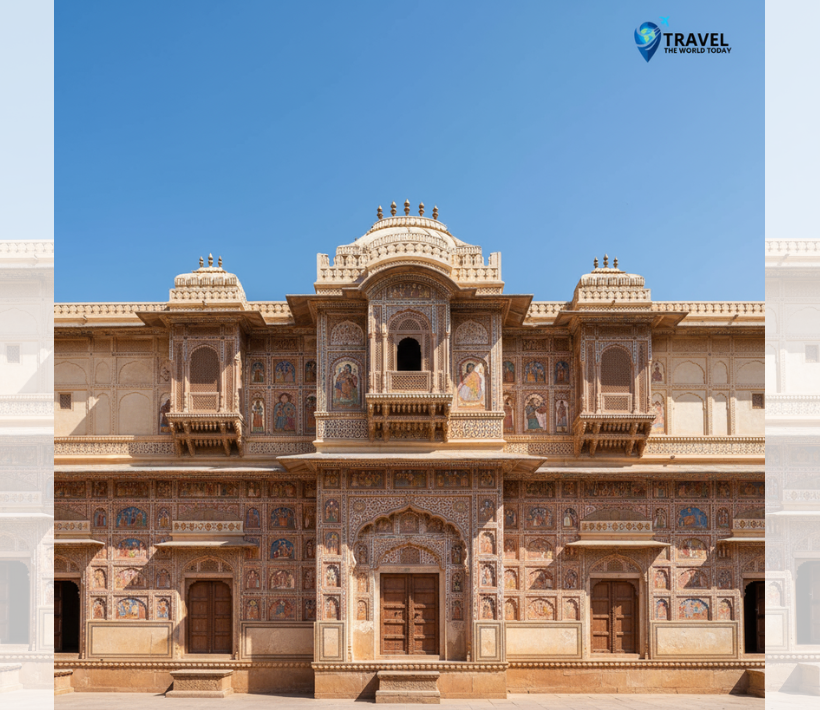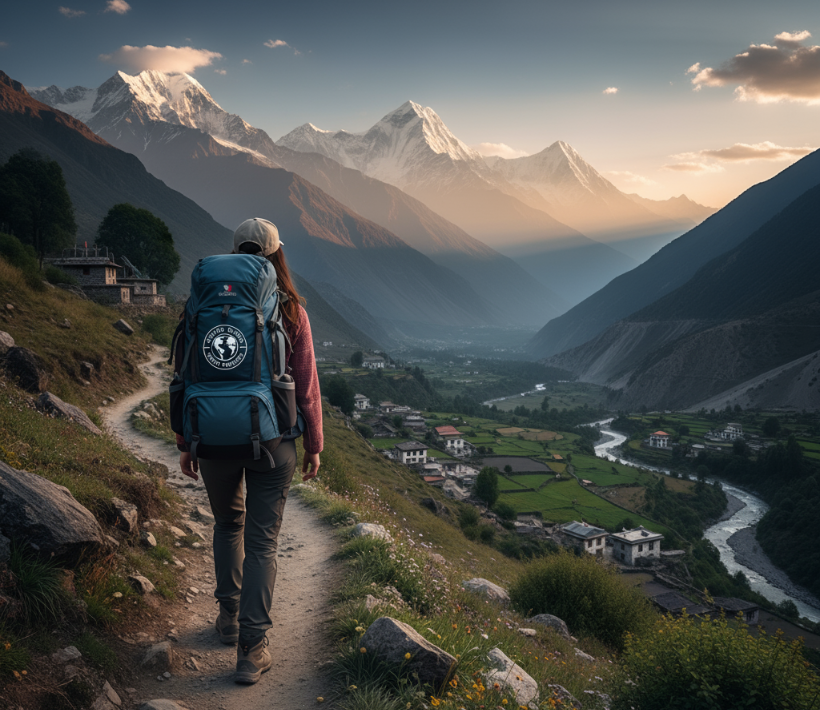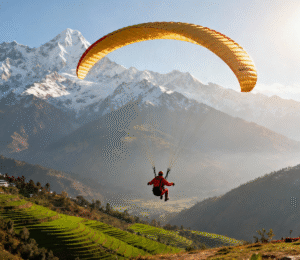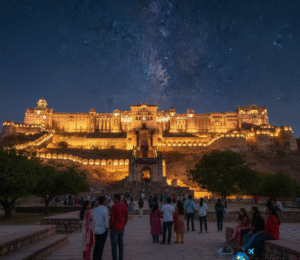What Makes Mandawa Havelis History So Unique in Rajasthan’s Heritage?
Did You Know Mandawa Has Over 100 Painted Mansions?
Have you ever been through an area where each building tells a story with vibrant artwork? Mandawa’s story is a treasure trove of more than 100 mansions decorated with art that transform the tiny Rajasthan city into an outdoor art gallery. These architectural marvels aren’t gorgeous structures. They’re time capsules which preserve the culture, wealth, and artistic brilliance of the 18th and 19th centuries in India.
Travel The World Today guides you through each step of learning the factors that make mandawa havelis’s story distinct in Rajasthan’s rich heritage. It will explain how merchants built these palaces with paintings, why their work stands out from other Rajasthani structures, and how to experience the living museum of now. If you’re planning your first trip or wish to know the significance of these mansions, this guide will provide you with all you need to know.
When you’re done reading this piece, you’ll know the best havelis to visit and where you can remain for a truly authentic experience and the best way to enjoy the stories that are painted on the walls of centuries-old buildings. Let’s get started on your journey through one of India’s least-known tourist destinations.
Understanding Mandawa Havelis History: The Basics
What Are Havelis?
Havelis are the traditional townhouses or mansions that wealthy merchants built all over North India. The word”haveli” is derived from the Arabic word “hawali,” meaning “partition” or “private space.” These weren’t typical houses. These were symbols of status that showed the wealth and taste of a family.
A typical haveli is characterized by an inner courtyard, which has multiple stories. The design includes elaborate gates, wooden doors with carvings, and windows with lattices known as “jharokhas.” What makes the history of mandawa havelis distinctive is the wide use of frescoes, which are paintings that are painted directly on the walls of wet plaster.
These mansions had multiple functions. The ground floor was used for businesses and storage. The upper floors offered living space for the entire family. The design was able to allow the air to circulate in the hot climate of Rajasthan and also provided the privacy of the family.
Why Mandawa Became the Haveli Capital
Mandawa is located inside Mandawa is located in the Shekhawati part of Rajasthan, which was once an important trade route that connected India as well as the Middle East. The 18th century was when Marwari merchants who managed this trade became wealthy. Instead of moving to large cities, they poured their wealth into their hometown.
The merchants competed to construct the most stunning mandawa-style haveli. Each family aimed to surpass others by painting more intricate and elaborate designs. This competitive spirit led to the mass of elaborate mansions that you can see in the present.
The town’s geographical location allowed for its perfect development. It was able to access skilled artisans from the nearby regions. Materials were easily accessible. In addition, merchants were looking to make a mark in their own community.
The Golden Era of Merchant Wealth
The most prosperous period of the mandawa havelis’s history runs from 1830 to 1930. The 20th century was a time of incredible growth and prosperity for Marwari merchants. They started trading companies that were based in Calcutta (now Kolkata), Bombay (now Mumbai), and even in the world.
Despite their successes elsewhere, however, these merchants maintained their strong ties with Mandawa. They sent money back to build extravagant havelis. The paintings represented the new experiences and concepts during their travels.
In the 20th century, the economic climate decreased the importance of trade routes. Merchant families gradually changed their focus to cities. Many of the havelis were abandoned or not maintained properly. Restoration efforts are currently aiming to protect this glorious heritage.
The Architectural Marvel Behind Mandawa Havelis
Unique Fresco Painting Techniques
The frescoes are what make mandawa’s history extraordinary. The techniques used by the artists were handed over generations. They applied a layer of lime, layered with marble dust to create an ideal surface for painting.
Artists were quick to work while the clay remained damp. They utilized natural pigments that come from plants, minerals, as well as precious stones. The gold leaf embellished important parts of the. The result? paintings that last for more than 200 years, with colors that are lively.
The subjects ranged from Hindu mythology to British colonizers. The paintings depict gods and goddesses along with steam bikes and engines. This mix of contemporary and traditional themes is not common and is unique in Indian art.

Structural Design Elements
Every mandawa haveli is built on the same architectural principles that are adapted to the local requirements. The main entrance features an impressive gateway adorned with intricate carvings. The gateway leads to the main courtyard, which is often utilized for business purposes and for entertaining guests.
The courtyards inside were private family areas. Female rooms (zenana) were distinct from the public spaces. Rooftop terraces were a place to sleep during the hot summer evenings. Multi-level designs maximized the space while maintaining the feeling of comfort.
Important architectural elements include:
- Jharokhas overhanging enclosed balconies that have latticed windows
- Chajjas: Eaves that project to offer shade and protection from rain
- Jaalis Stone screens that are intricate allow airflow, while preserving the privacy
- Chhatris: A decorative dome-shaped pavilion that is found on rooftops
Materials Used in Construction
The builders used local materials to make their structures durable and climate-friendly. The principal material was bricks made of local clay. The bricks were clad with lime plaster, which provided both protection as well as a painting surface.
The wood beams and pillars were sourced directly from the nearby woods. Artisans created intricate patterns for windows and doors. Stone was only used sparingly, mostly to build foundations and decorative elements.
The quality of construction is the reason the buildings have stood up to the harsh desert conditions. The walls are thick and provide great insulation. The tall ceilings and a ventilation system ensure that the interiors remain cool even when temperatures outside rise.
Famous Havelis You Must Visit in Mandawa
Goenka Double Haveli Mandawa
It is believed that the Goenka Double Mandawa is among the top in the city. Like the name suggests, it is actually two havelis that were built by two brothers of the Goenka merchant family. The building is an example of the highest quality of Shekhawati’s fresco art.
There are paintings on all surfaces. The walls outside include scenes from Krishna’s story as well as photographs of European women in Victorian fashion. This juxtaposition perfectly reflects the era’s cultural exchange. period.
In the interior, the courtyards show the intricate designs. The motifs of religion blend with everyday life scenes. The precision of the work is breathtaking. Artists painted each flower, bird, and other patterns with amazing accuracy.
Gulab Rai Ladia Haveli Mandawa
Gulab Rai Ladia Mandawa is notable for its European-inspired architectural style. It was built in the beginning of the 1900s. The haveli demonstrates the way that merchant wealth and Western exposure affected later buildings. The façade is decorated with paintings of airplanes, motor cars and telephones, modern innovations that captivated the first owner.
The most famous work of the Haveli depicts an European man utilizing a telephone. This was a first for a tiny Rajasthan town at the beginning of 1900s. Some walls show gods on bikes and elephants, mixing tradition with modernity.
The architectural style mixes the traditional haveli style with colonial features. There are more windows than traditional havelis, and a different proportion of the structure of the building. This is a great model of architectural transition.
Golden Haveli Mandawa
Golden Haveli Mandawa was named after the numerous uses of gold leaf in its artwork. The shimmering walls create a mystical atmosphere, particularly during golden hour when the sun hits the façade. This hasli is the most impressive display of the wealth of the merchant.
The artworks here are centered on themes of religion. The detailed representations of Ramayana and Mahabharata scenes are aplenty on the walls. The artists employed the most exquisite colors available, which resulted in vibrant colors that are still vivid to this day.
Today, a portion of the haveli is used as a heritage hotel. Visitors can stay overnight and experience the the authentic lifestyle of a haveli. The work of restoration was done with care to keep the original features intact as well as incorporating modern features.
Murmuria Haveli
Do not be averse to Murmuria Haveli, which is famous for its unique mirrorwork along with paintings featuring trains. The owners of the museum commissioned a special painting featuring steam locomotives as a symbol for British Indian modernization. These paintings are an invaluable historical evidence of how railways appeared in the latter half of the 1800s.
The haveli has a variety of peacock-themed designs. In Rajasthan, the peacock symbolizes wealth and beauty. Artists painted thousands of these birds on ceilings and walls with slight variations in their poses and patterns.
The technique of mirrorwork is different from other havelis. The tiny mirrors are inserted into the plaster, resulting in sparkling surfaces that reflect the light beautifully. This was a costly method that was reserved for the richest families.
Comparison Table: Top Mandawa Havelis
| Haveli Name | Special Feature | Best For | Current Status | Entry Fee |
|---|---|---|---|---|
| Goenka Double Haveli | Extensive frescoes mixing Indian & European themes | Art enthusiasts | Museum | ₹50-100 |
| Gulab Rai Ladia Haveli | Modern technology paintings (cars, phones) | History buffs | Partially open | ₹30-50 |
| Golden Haveli | Gold leaf work, religious scenes | Photography | Heritage hotel | Free for guests |
| Murmuria Haveli | Train paintings, mirror work | Architecture lovers | Private (exterior viewing) | Free |
| Jhunjhunwala Haveli | Battle scenes, largest courtyard | First-time visitors | Fully accessible | ₹100 |
How to Experience Mandawa Havelis History: Step-by-Step Guide
Step 1: Planning Your Visit
Decide on the time you would like to go through the history of mandawa havelis. The most ideal time is between October and March, when temperatures are a comfortable temperature to walk tours. Avoid the summer months (April-June) when temperatures during the daytime surpass 40 degrees Celsius (104degF).
Make sure you have at least two complete days to Mandawa. Day one is dedicated to the main havelis located in the town’s center. Day two lets you discover lesser-known mansions and villages. If you’re in a hurry A well-planned day trip will cover the some of the highlights.
Plan your accommodation prior to the time of the season of peak demand (December-January). A stay in a mandawa haveli that is a heritage site, is a true experience and convenient access to tourist destinations. The havelis that are being researched are accessible to tourists, and they are also private homes.
Step 2: Choosing Your Accommodation
The hotel you choose to stay in will greatly impact the experience you have. Mandawa hotels include budget guesthouses to luxurious heritage hotels. Each has its own advantages when it comes to exploring the history of mandawa’s havelis.
Vivaana Mandawa The HTML0 Vivaana Mandawa is an elegant heritage hotel that was reconstructed from the historical Mandawa Castle. The resort offers regal treatment along with modern amenities, while staying in the historical building. The property offers guided tours and cultural events.
The Hotel Radhika Haveli Mandawa offers moderate prices with authentic architecture of the haveli. The owners are locals and offer valuable insight into the mandawa history of havelis. Rates for rooms include guided walks of nearby havelis.
For those on a budget, you should think about Mandawa Fort Shekhawati guesthouses in the area. These guesthouses are near major tourist attractions but without breaking the budget. Many of them have views from the rooftops or painted havelis.
Step 3: Navigating the Town
Mandawa is small and should be explored by walking. Mandawa is the main havelis cluster is within a one-kilometer distance from the town’s center. Begin early in the morning in the morning when the light is ideal for photography and the temperatures are cool.
Employ a local guide for your first trip. They’ll discuss the significance of artwork and will share stories from families about every mandawa’s haveli. Guides are charged between Rs500 and 1000 for a half-day trip. Their experience transforms your trip from a sightseeing tour to a cultural experience.
Plan a walk that reduces the amount of backtracking
- Start at the Goenka Double Haveli in the early morning
- Go to Murmuria Haven (5-minute stroll)
- Visit Gulab Rai Ladia Haveli before lunch
- Exploring Golden Haveli in afternoon light
- Stop at a traditional hotel to enjoy sunset views

Step 4: Understanding the Art
The ability how to “read” haveli paintings enhances your understanding of the history of mandawa havelis. The frescoes are based on certain themes and symbols. Understanding these patterns can help you to understand specific sections’ goals.
Religious artworks are typically found in prayer rooms as well as main halls. Find scenes that are based on Hindu epics, particularly Krishna’s childhood tales. In the Hindu epics, stories like Ramayana and Mahabharata were a constant source of inspiration for artists.
Daily life-style scenes depict the way people lived in the time. Women drawing water, men running business and kids playing games. These paintings provide authentic historical documents from the 19th century of Rajasthan.
Modern features represent the merchants exposed to British India as well as other countries. Trains, motor vehicles, aircrafts, and European figures are exhibited alongside the traditional subjects. This mix of cultures is what makes the history of mandawa havelis distinct in the world of Indian heritage sites.
The Stories Behind the Painted Walls
Religious and Mythological Themes
Hindu mythology is the dominant theme in haveli artworks, expressing the merchants’ profound convictions in religion. Krishna is seen stealing butter (Makhan Chor) is seen repeatedly, a symbol of the innocence of children and love for God. Artists depicted him wearing blue skin playing his flute and being surrounded by beautiful Gopis (milkmaids).
Rama’s story in the Ramayana fills entire walls of a few havelis. You’ll find key scenes, such as Rama cutting Shiva’s bow in half, his escape towards the woods, his kidnapping, and the final fight with Ravana. The narratives of these sequences were similar to comic books of the time.
Ganesha and Lakshmi are prominently portrayed as gods of prosperity and success. Merchants specifically worshipped these gods as they believed that they would bring prosperity to their businesses. These paintings were used for both for decorative and religious purposes.
Colonial Influences
British colonization significantly influenced the history of the mandawa havelis. Merchants who dealt in British-controlled cities brought fresh ideas and concepts. Artists were able to incorporate these ideas into their traditional art, resulting in an original art fusion.
European males and females are dressed in Victorian-style clothing. Some paintings depict British soldiers, officials, as well as memsahibs (British women living in India). They are often portrayed with Hindu gods, creating bizarre but intriguing compositions.
Modern technology has fascinated artists and merchants. Steam trains symbolize progress and British power. Bicycles, phonographs and telephones are icons of modernity. A famous painting depicts gods riding these devices–a wonderful mix of modern and old.
Daily Life Depictions
Beyond the colonial and religious images The paintings depict the everyday life in 19th century Rajasthan. These scenes offer valuable historical details about clothes fashion, customs, and social norms. There are wedding procession as well as market scenes and royal courts.
Women’s activities are the focus of focus. The paintings depict women doing chores at home, observing festivals and socializing. These paintings reveal a lot about women’s lives in the time when they seldom kept historical archives.
Battle scenes and hunting excursions showcase the masculine traits that were appreciated within Rajput society. The warriors on horseback hunting tigers, as well as palace parties show the kind of lifestyle that merchants sought to achieve regardless of their economic background.
Where to Stay: Heritage Hotels in Mandawa
Mandawa Fort Shekhawati
Mandawa Fort Shekhawati area provides a range of lodging choices ranging from budget-friendly to mid-range. The fort is sometimes used as a heritage hotel subject to seasonal activities. The fort’s location puts you in the middle of the haveli countryside.
The guesthouses that are budget-friendly around Fort charge between Rs800 and 1500 per night. These rooms offer basic facilities and rooftop restaurants that have Haveli views. The owners frequently organize guided tours as well as cultural events.
Mid-priced hotels provide more comfort with air conditioning, more bathrooms, and meals included. Prices vary from Rs2000 to Rs4000 per night. A lot of them are restored offering an authentic architecture experience.
Vivaana Mandawa
Vivaana Mandawa is the highest quality of accommodation. The resort is located in the historical Mandawa Castle, completely renovated to five-star standards. It offers royal living, modern amenities and flawless service.
The hotel has elegantly decorated rooms that are furnished with antique furniture and contemporary bathrooms. Its restaurant offers traditional Rajasthani food, as well as continental dishes. Evening cultural shows include dance and folk music shows.
Prices start at 15,000 rupees per night, but they come with a wide range of amenities. The infinity pool has panoramic views of the town’s painted Havelis. Staff can organize customized tours, camel rides and village tours. This is a great option for tourists seeking luxury when exploring the rich history of mandawa havelis.

Hotel Radhika Haveli Mandawa
hotel Radhika Haveli Mandawa provides the perfect blend of authenticity and luxury. This renovated haveli retains the traditional architecture, while providing modern amenities. The family-run hotel offers personalized attention as well as local insight.
Rates for rooms range from $300 to 6000 per night, depending on the size of the room and the season. The rooms are decorated in a traditional style and modern bathroom facilities. Rooftop restaurant offers traditional home-cooked Rajasthani dishes made with traditional recipes of the family.
The family that owns the property has lived in Mandawa for many generations. They have stories to tell about the history of Mandawa Havelis which you can’t find in guides. Free walking tours will aid in understanding the historical background of the art.
Heritage Haveli Mandawa Options
A number of smaller traditional mandawa properties are operated with guesthouses and boutique hotels. They offer intimate experiences, with fewer rooms and personalised service. They are typically family-run businesses where you’ll be able to meet the ancestors of the first haveli builders.
The properties are charged between Rs2000 and 5000 each night to sleep located in restored parts of the historical havelis. You’ll be sleeping in rooms that feature original frescoes, as well as carved wooden furniture. Food is often shared by the entire family offering cultural exchange opportunities.
Booking these properties, which are smaller in size, requires planning in advance. They aren’t listed on booking sites for international travelers. You can contact them directly on their social media sites or on their websites. This extra effort is rewarded with authentic experiences that aren’t available at larger hotels.
Preservation Challenges and Restoration Efforts
Mandawa havelis’s history has serious challenges to preserve it. A lot of mansions are privately owned by family members who aren’t able to afford maintenance. The elements of weather, pollution and neglect eventually damage fragile frescoes. Without intervention, this artefact may disappear in just a few generations.
The greatest danger could be water-related damage. The monsoon rains of Rajasthan penetrate wall and roofs that have been poorly maintained. The water causes the plaster to degrade and paintings fade. The groundwater salt rises up walls, leaving white spots which ruin artwork.
Many organizations are working to conserve these treasures. They include the Indian National Trust for Art and Cultural Heritage (INTACH) records havelis and provides advice on the restoration. International grants fund major restoration projects in the most important havelis.
Certain wealthy families have transformed the havelis to heritage hotel. This generates income to maintain the hotel while providing the public to use them. But, renovations have to keep in mind the modern needs and historic preservation. Incorrect restorations can ruin the original design permanently.
Tourism serves a dual purpose. The fees paid by visitors support preservation efforts as well as provide incentives for the maintenance of. But, if not controlled, tourism could harm fragile structures. The right amount of balance is an ongoing problem for mandawa havelis’s historical preservation.
Best Time to Visit and Travel Tips
Optimal Visiting Season
The best time to discover the mandawa history is November to February. Temperatures during the day range between 15-25 degrees Celsius (59-77degF) which is ideal to take a walk. Evenings can be cold and drop to 5-10 degrees Celsius (41-50degF) So, take warm clothes.
The months of October to March is shoulder months with fewer visitors and a more moderate temperatures. The temperature rises towards March but they remain comfortable. You’ll find lower hotel prices and less packed havelis throughout this time of year.
Do not visit from April to September. Summer temperatures exceed 40degC (104degF), making outdoor exploration uncomfortable. In the monsoon period (July-September) is characterized by intermittent rain which can cause disruption to travel plans. Numerous smaller hotels close in the off-season months.
Getting There
Mandawa is situated within Rajasthan’s Jhunjhunu district, which is about 180 km away from Jaipur. The majority of visitors travel via Jaipur which is a great city with excellent train and air connectivity. From Jaipur you can choose from a range of transportation options.
In a automobile: The 3-4-hour drive from Jaipur provides the greatest flexibility. Hire a driver-driven car for a cost of Rs3000-4000 round trip. The road passes through the rural Rajasthan and offers stunning photographs and stunning views.
by bus Private and government buses are regularly operating starting from Jaipur up to Mandawa. The journey lasts 4 to 5 hours and costs between 200-400 rupees. Buses are simple, but useful for travelers on a budget.
Train The closest train station to Mandawa is Jhunjhunu which is located 30 kilometers away from Mandawa. Trains with limited connections connect Jaipur as well as Delhi. From Jhunjhunu you can hire an auto (Rs500-700) from Jhunjhunu to Mandawa.
Essential Travel Tips
- Find an experienced guide for at the very least the first day. Local guides can cost between Rs500 and 1000, but will dramatically increase your knowledge of mandawa’s history.
- Cash is a must since ATMs aren’t plentiful and credit cards aren’t widely accepted. Take enough rupees to cover accommodation and meals as well as entry fees and shopping.
- Take a pair of comfy walking sneakers because you’ll be spending hours exploring the city on your feet. The narrow streets of the town and uneven terrain require robust shoes.
- Respect private property. Many havelis remain houses. Always seek permission prior to taking photos or entering. Certain families charge small fees (Rs20-50) for entry.
- Bring your photography equipment but make sure you ask prior to taking pictures of people. The best lighting for photography is between early morning and late afternoon. Make use of a wide-angle lens to take pictures of the entire facade.
- Keep hydrated especially in the summer seasons. Keep a water bottle that is reusable and refill it at hotels. The dry climate can cause rapid dehydration, which is not what you imagine.
- Learn basic Hindi phrases or Rajasthani greetings. Locals appreciate your efforts and will often share additional details with visitors who are friendly.

Numbered Guide: 7 Steps to Photograph Mandawa Havelis Like a Pro
- Check out the website during golden hour (6-8 am or 4 – 6 pm) as angled sunlight intensifies the colors and casts striking shadows over painted façades.
- Utilize the Polarizing filter to cut down reflections on walls and create blue skies, allowing the frescoes’ colors pop even more brightly.
- Incorporate human elements such as locals passing by havelis, to give dimension and life to architectural photos.
- Concentrate on the specifics rather than taking zooming in on the individual paintings, doors carved and other decorative elements.
- Try different perspectives using shots from the street, on rooftops and through doorways to create different perspectives of mandawa’s haveli..
- Capture the decay along with the beauty of peeling paint and crumbling walls tell vital tales about mandawa’s history and preservation requirements.
- Create comparisons between before and after through researching photos from the past and re-creating angles to demonstrate how the structures have changed in the course of time.
Key Takeaways: Understanding Mandawa Havelis History
- Mandawa has more than 100 exquisite havelis, which makes it among the largest open-air art galleries that exhibit frescoes of the 18th and 19th centuries.
- The paintings combine traditional Indian themes alongside modern and colonial images and create a distinctive aesthetic style that documents the cultural exchanges throughout British rule.
- Trade routes helped fund these extravagant mansions as status symbols, and families competed to build the most stunning structures.
- The best time to visit is from November to Februar,y with warm temperatures that permit long walks through the town’s compact center.
- Hotels that are heritage-based, such as Vivaana Mandawa or Hotel Radhika Haveli Mandawa provide authenticity while also helping to preserve the environment.
- Preservation faces several challenges due to weather-related destruction, neglect, and the lack of resources, making regular visits crucial to explore these precious treasures.
- Local guides greatly enhance understanding of the meaning behind painting families, the history of families, and the cultural context that’s not apparent to casual viewers.
Conclusion: Your Journey Through Mandawa Havelis History Awaits
Mandawa havelis’s rich historical significance provides something unique–an opportunity to experience the living past where each building has stories of artful brilliance, merchant ambition, and cultural exchange. These mansions painted with paint aren’t just gorgeous structures. They’re time capsules that preserve an era in time when the traditional India met modern colonialism.
You’ve learned the factors that make these havelis unique with regard to their techniques of fresco to their unique mix with Hindu mythology, and Victorian modernity. You’ve figured out what goenka double haveli, gulab rai Ladia Haveli Mandawa and mandawa made of gold merit your attention. You know the best way to plan your trip the best way to get there, where to stay and what to find in the artworks.
The urge to travel is never greater. The challenges of preservation threaten these treasures and each anniversary brings more damage due to inattention and weather. If you visit now you are helping local economies and efforts to preserve them as you experience a heritage that may be lost to the next century without more attention and resources.
Explore The World Today encourages you to consider making Mandawa your next destination of heritage. This tiny Rajasthan town is a punch above its weight when it comes to historical and artistic value. If you’re a fan of architecture or a history buff, or a curious traveler, mandawa havelis history will fascinate and excite you.
Are you eager to discover Rajasthan’s mansions with paintings? Start planning your Mandawa adventure now. Reserve your Mandawa heritage haveli accommodation, look up the most suitable havelis that suit your need,s and get ready for a memorable experience. The art gallery that is open to the public in Mandawa is waiting to be discovered!

FAQs About Mandawa Havelis History
Q1 What is the average age of Mandawa Havelis?
Most havelis date from the year 1830 until 1930, which means they are between 90 and 190 years old. The oldest structures that remain were built in the late 18th century. The most modern ones were constructed in the 20th century, before merchants moved to bigger cities.
Q2 Do all havelis are open to guests?
No, many havelis remain private residences of family members. A majority of havelis offer access to the public, while some charge tiny admission costs (Rs20-100). Always get permission prior to visiting or taking pictures of private homes.
Q3: What is it that makes Mandawa distinct than the other Rajasthani historical places?
Mandawa havelis historical significance is unique due to the sheer number of mansions painted within a small town. The frescoes mix the traditional Indian themes with modern and colonial imagery and create a distinctive style of art that isn’t found in other places.
Q4: Do I have the right to live in the Haveli?
Yes! Many havelis are now operating as mandawas of the past, which are now hotels. These range from basic guesthouses to luxurious resorts. Overnight stays offer authentic ambience and easy access to the tourist attractions.
Q5: How long should I stay at Mandawa?
Plan for two full days to fully investigate the history of the mandawa havelis. One day is dedicated to the main havelis of the town’s central area. The second day is for more exploration of the mansions that aren’t well-known and the nearby villages painted.
Q6 What is the originality of the painting or have they been restored?
Most paintings you can see are original. However, certain paintings have been restored. Restored works that are done properly employ traditional methods and materials. It is usually possible to differentiate the restored areas by slightly brighter hues.
Q7: What’s the most effective method of getting to Mandawa?
Most visitors are via Jaipur (190 km and 3-4 hours drive). Hire a chauffeured car is priced at Rs 3000-4000 for a round trip. Alternately, you can use an auto (Rs200-400) and train from close by Jhunjhunu or Jhunjhunu, and taxi to Mandawa.
Q8 Can photography be done in the haslis?
Photography rules vary according to the property. Museum havelis typically permit photography that is not flash with an additional cost (Rs20-50). Private havelis require the permission of the owners. Always seek permission prior to taking pictures.
Q9 How should I dress while visiting a haveli?
Wear modest, comfy clothing that is that is suitable for walking. Be sure to cover knees and shoulders particularly when visiting havelis in lively places of worship. Walking shoes that are comfortable are crucial for walking on uneven terrains.
Q10: Do you have guided tours offered?
Yes, local guides can offer walking tours for between Rs500 and 1000 per half-day. The hotels in Mandawa can help you arrange guides. You might consider joining a tour with a group to save money while getting the most up-to-date information on the history of mandawa havelis.

Hi, I am Raghav Ahuja a curious explorer, travel enthusiast, and the voice behind Travel The World Today. I believe in discovering the beauty of every destination without breaking the bank. Through my journeys, I share tips, stories, and travel guides to help you explore the world on a budget. Whether you’re a solo adventurer, a family traveler, or just planning your next escape, I’m here to inspire and guide you every step of the way.







Post Comment